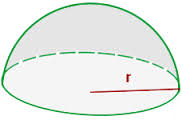Hemisphere Mass
Tags | |
UUID | 3cf6bbad-76f8-11e7-9770-bc764e2038f2 |
The Mass of a Hemisphere calculator computes the mass or weight of a hemisphere based on the radius and the mean density of the material in the hemisphere. UPDATE: New unit default of millimeters and a default density of steel.
the mean density of the material in the hemisphere. UPDATE: New unit default of millimeters and a default density of steel.
INSTRUCTIONS: Choose units and enter the following:
- (r) Radius of Hemisphere.
- (mD) Mean Density (Default is for Steel: CLICK HERE for the mean density of many substances)
Hemisphere Weight or Mass (M): The calculator returns the mass in grams (g). However, this can be automatically converted to other mass or weight units via the pull-down menu.
- Mean Density Lookup: This provides the mean density of many substances and materials.
The Math / Science
A hemisphere is one half of a sphere. The formula for the mass of a hemisphere is:
M = (2*π*r3)/3 * mD
where:
- M = Mass of the Hemisphere
- r = radius of the sphere
- mD = Mean Density of Material
This formula first computes the volume of the hemisphere based on the input parameters. With the computed volume, this formula then executes the simple equation below to compute the approximate mass of the object.
A hemisphere is half of a sphere. The boundary is a great circle that goes through the center of the sphere.
Hemisphere Calculators
Metals are materials characterized by its physical and chemical properties, primarily its ability to conduct electricity and heat, its luster or shine when polished, its malleability (ability to be hammered or pressed into shapes), and its ductility (ability to be drawn into wires). Metals typically have a crystalline structure and are found naturally in solid form (with the exception of mercury, which is a liquid at room temperature).
|
Metals Densities
|
Metals make up a large portion of the periodic table of elements, with examples including iron, copper, gold, silver, aluminum, and titanium, among many others. Metals are essential in various industries such as construction, manufacturing, electronics, transportation, and energy production due to their unique properties and versatility.
Metals are generally dense materials. Density is a measure of how much mass is contained in a given volume. Metals tend to have high densities because their atoms are closely packed together in a crystalline structure. This close packing of atoms contributes to their characteristic properties such as strength, malleability, and conductivity.
However, it's important to note that the density of metals can vary widely depending on factors such as their elemental composition, crystal structure, and any impurities present. For example, some metals like lead and platinum are denser than others like aluminum or magnesium.
The Weight of Metal Calculator contains functions and data to compute the weight (mass) of metal objects based on their size, shape and the density of the metal. The Weight of Metal functions are:
- Cylinder Weight: Computes the weight (mass) of a cylinder based on the radius, length (height) and density of metal.
- Sphere Mass: Computes the mass (weight) of a sphere based on the radius and density of metal.
- Hemisphere Mass: Computes the mass (weight) of a hemisphere based on the radius and density of metal.
- Weight of Metal Bars: Computes the mass (weight) of a number of metal flats or metal bars based on the dimensions and density of metal.
- Weight of Metal Rods: Computes the mass (weight) of a number of metal rods based on the dimensions and density of metal.
For the mean densities of other substances click HERE.
Collections
- Comments
- Attachments
- Stats
No comments |

